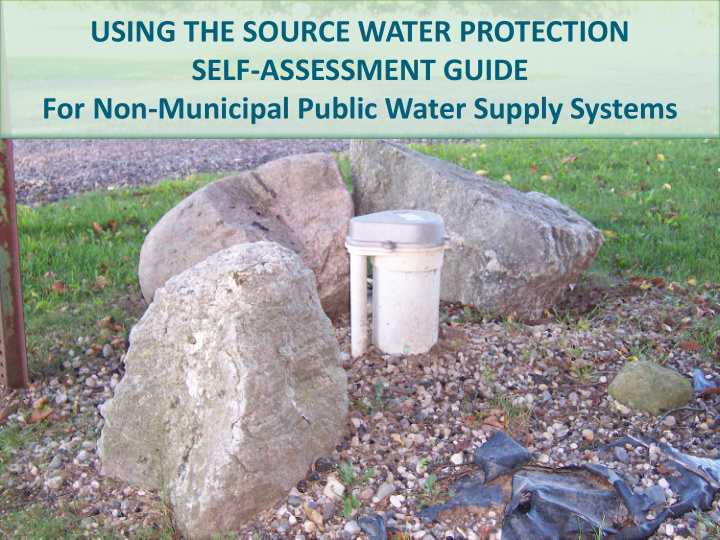



USING THE SOURCE WATER PROTECTION SELF-ASSESSMENT GUIDE For Non-Municipal Public Water Supply Systems
Contamination Happens!
What’s Next? What Can You Do?
Source Water Protection Guide Use the information to develop long-term strategies to protect your drinking water source
Self-Assessment Guide Well Integrity and Management Wastewater Management Managing Hazardous Products Storm Water Runoff Management Managing Site Waste Assess risk Develop an Action Checklist for Medium and High Risks
Well Integrity and Management
Basic Soil Formation
Permeability of Top Layer
Thickness of Protective Layer 10 Feet <10 Feet
Static Water Level Surface More than 40 Feet from Ground Surface 10 to 40 Feet Below Ground Surface Less Than 10 Feet Below Ground Surface
Age of the Well Constructed After 1994 Constructed Between 1976 & 1994 Constructed Prior to 1976
Well Grouting Grouted According to Current Rules Partially or Poorly Grouted Not Grouted
Condition of Well Casing & Cap Approved Cap No Holes or Cracks Tightly Secured Screened Vent Unapproved Cap Cracks, Holes, or Loose Casing, Cap, or Conduit
Protection of Wellhead No Chemicals Applied Onsite. Grade Slopes Away From Wellhead No Chemicals Applied Near Well Casing. Grade Slopes Away From Wellhead Chemicals Applied Near or At Wellhead. Grade Slopes Toward Wellhead
Casing Height Above Grade 12 Inches or More From Grade Level to Less Than 12 Inches Below Grade, in a Pit, or in a Basement
Surveillance of Wellhead Wellhead Readily Visible & is Protected From Damage Wellhead Readily Visible But Not Protected From Damage Wellhead Not Readily Visible & Not Protected From Damage
Inspected by Registered Driller Within the Past 10 Years Between 10 & 20 Years Ago More Than 20 Years Ago or Don’t Know
Wastewater Management On-Site Disposal
Septic System Size/Age <5 Years Old 6 to 20 Years Old More Than 20 Years Old
Distance of Separation >75 or 200 Feet 50-75 or 100-200 Feet <75 or 200 Feet
Septic Tank Last Pumped Within the Past 5 Years 5 to 10 Years More Than 10 Years
Signs of Trouble Drains Flow Normally No Sewage Odors Soil Over Drainfield Dry & Firm Drains Run Slowly or Soil Over Drainfield Sometimes Wet Sewage Odors Drains Back Up Soil Wet or Spongy
Records Maintained Good Map & Records of System Repairs & Maintenance Some Records Maintained No Map or Maintenance Records Kept
Cleaners, Solvents & Other Chemicals Poured Down Drain Moderate Use of Cleaning Products Discharged with Wastewater. No Hazardous Chemicals Poured Down Drain. Moderate Use of Products. Very Small Amounts of Hazardous Chemicals Poured Down Heavy Use of Products. Hazardous Chemicals Discharged in Wastewater
Lagoons & Feed Lots Outside WHPA >2000 or 800 Feet Outside WHPA but <2000 or 800 Feet Within the WHPA
Managing Hazardous Products
Pesticides, Fertilizers, Cleaning Agents & Fuel - Storage No Products/Fuel Stored on Site. Any Storage >2000 or 800 Feet. Isolation Maximized Proper Storage, Secondary Containment. Products in Well Room, No Containment, <200 or 75 Feet.
Pesticides, Fertilizers, Cleaning Agents & Fuel - Use Pesticides & Fertilizers Not Applied or Applied as Directed Pesticides Applied Away From Wellhead Applied Too Close to Wellhead & Excessively
Pesticides, Fertilizers, Cleaning Agents & Fuel - Disposal Products Used or Completely Removed From Site Waste Products Stored on Site and/or Disposed in Landfill Products Disposed of Near Well, Surface Water or Poured Down a Drain
Storm Water Management
Paved Surfaces Surface Runoff Diverted Away From Wellhead Minimal Runoff Toward Wellhead Excessive Amount of Runoff Runs Toward Wellhead
Landscaping & Buffer Strips Landscaping Slows Storm Water Flow & Provides Areas Where Water Soaks into Ground Away from Wellhead Minor Landscaping Minimizing Runoff Toward Wellhead No Landscaping to Slow Flow of Storm Water or Surface Water
Distance From Surface Water Well Located >200 or 75 Feet From Surface Water Well Located >200 or 75 Feet From Surface Water with at Least 10 Feet of Protective Clay Layer Well Located <200 or 75 Feet From Surface Water with No Protective Clay Layer
Managing Site Waste
Waste Disposal Only Organic Wastes are Disposed of On Site Waste Stored On Site While Waiting for Removal/Use Wastes Improperly Discarded to Land, Sewer or Storm Drains
Waste Liquids Kept in Secure Stored in Non-secure Improperly Disposed of Containers With Containers and/or at an On-Site Location Secondary Without Secondary Containment Containment
Time To Evaluate & Reduce Your Risks!
Recommend
More recommend